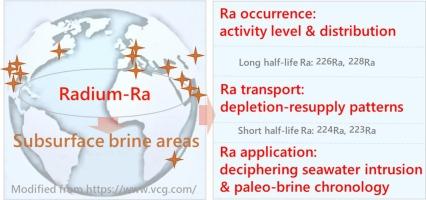Global perspectives on radium isotopes in subsurface brines
IF 7.2
1区 地球科学
Q1 GEOSCIENCES, MULTIDISCIPLINARY
引用次数: 0
Abstract
Subsurface brines constitute critical reservoirs of strategic resources. Global radium (Ra) isotope data from ∼27 brine systems reveal Ra occurrence, transport, and applications. Elevated Ra activities exhibit spatial covariation with total dissolved solids (TDS), with significant proportions exceeding World Health Organization (WHO) standards and industrial limits. Quadruple Ra isotopes (226Ra, 228Ra, 224Ra, 223Ra) revealed salinity-dependent “ridge” patterns, indicating sequential desorption-precipitation controls. Global-scale Ra co-precipitation thresholds were determined as 102.33–128.82 g/L TDS through nonlinear logarithmic regression analysis. Short-/long-lived Ra ratios further decode dynamics governed by recoil, weathering and aquifer lithology. Elevated 228Ra/226Ra and 224Ra/228Ra ratios in coastal brines (∼40.8% and 65.0%, respectively) signal active seawater intrusion, whereas depleted ratios in inland system (∼59.8% and 36.0%, respectively) denote stable paleo-brine preservation. We design dual Ra mass-balance models quantifying modern intrusion rates (via 224Ra/228Ra) and paleo-brine ages (via 228Ra/226Ra), coupled with enhanced strategies. Despite model parameters and colloidal Ra transport uncertainties, this Ra-centric approach establishes a transferable framework for managing strategic brine resources in the Anthropocene.

地下盐水中镭同位素的全球观点
地下盐水是战略资源的关键储层。来自~ 27卤水系统的全球镭(Ra)同位素数据揭示了Ra的赋存、迁移和应用。Ra活性升高与总溶解固体(TDS)呈空间共变,其显著比例超过世界卫生组织(WHO)标准和工业限值。四重Ra同位素(226Ra, 228Ra, 224Ra, 223Ra)显示出与盐度相关的“脊”型模式,表明有顺序的解吸-沉淀控制。通过非线性对数回归分析,确定全球尺度Ra共降水阈值为102.33 ~ 128.82 g/L TDS。短/长寿命的Ra比值进一步解码由反冲、风化和含水层岩性控制的动力学。在沿海系统中,228Ra/226Ra和224Ra/228Ra比值升高(分别为40.8%和65.0%)表明活跃的海水入侵,而在内陆系统中,228Ra/226Ra比值下降(分别为59.8%和36.0%)表明古盐水保存稳定。我们设计了双Ra质量平衡模型,量化了现代入侵率(通过224Ra/228Ra)和古盐水年龄(通过228Ra/226Ra),并结合了增强策略。尽管存在模式参数和胶体Ra输运的不确定性,但这种以Ra为中心的方法为管理人类世的战略卤水资源建立了一个可转移的框架。
本文章由计算机程序翻译,如有差异,请以英文原文为准。
求助全文
约1分钟内获得全文
求助全文
来源期刊

Gondwana Research
地学-地球科学综合
CiteScore
12.90
自引率
6.60%
发文量
298
审稿时长
65 days
期刊介绍:
Gondwana Research (GR) is an International Journal aimed to promote high quality research publications on all topics related to solid Earth, particularly with reference to the origin and evolution of continents, continental assemblies and their resources. GR is an "all earth science" journal with no restrictions on geological time, terrane or theme and covers a wide spectrum of topics in geosciences such as geology, geomorphology, palaeontology, structure, petrology, geochemistry, stable isotopes, geochronology, economic geology, exploration geology, engineering geology, geophysics, and environmental geology among other themes, and provides an appropriate forum to integrate studies from different disciplines and different terrains. In addition to regular articles and thematic issues, the journal invites high profile state-of-the-art reviews on thrust area topics for its column, ''GR FOCUS''. Focus articles include short biographies and photographs of the authors. Short articles (within ten printed pages) for rapid publication reporting important discoveries or innovative models of global interest will be considered under the category ''GR LETTERS''.
 求助内容:
求助内容: 应助结果提醒方式:
应助结果提醒方式:


